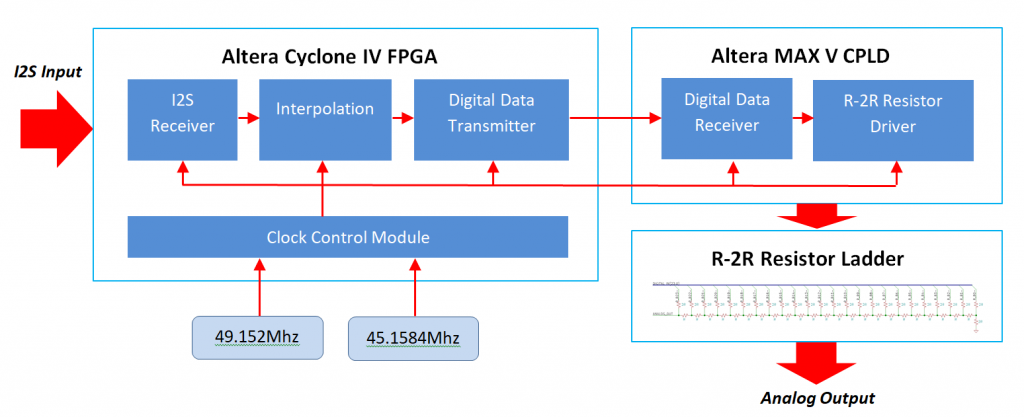- Audio DAC is classified to:
- R2R ladder
- Delta-Sigma 1 bit
- Delta-Sigma multi-bit
- The basic of R-2R resistor ladder DAC
The R-2R resistor ladder network directly converts a parallel digital symbol/word into an analog voltage

(24 bit R-2R resistor ladder)
The R–2R network causes these digital bits to be weighted in their contribution to the output voltage Vout. Depending on which bits are set to 1 and which to 0, the output voltage (Vout) will have a corresponding stepped value between 0 and Vref minus the value of the minimal step, corresponding to bit 0. The actual value of Vref (and the voltage of logic 0) will depend on the type of technology used to generate the digital signals.
For a digital value VAL, of a R–2R DAC with N bits and 0 V/Vref logic levels, the output voltage Vout is:
Vout = Vref * VAL / 2^N
3. Digital Design (Verilog) FPGA-based R-2R resistor ladder DAC

(R-2R DAC block diagram)

(R-2R DAC RTL diagram – Quartus Software)
I2S Receiver module:
The I2S protocol is a common standard used to send audio data. It is a serial protocol very similar to SPI, but it is a streaming protocol. That means it is always transmitting data. I2S sends a stream of stereo audio data. For each audio sample there is a left channel and a right channel value. The values can be any number of bits, although 16, 20, 24, and 32 bit values are the most common

(I2S Protocol timing diagram)
Clock Control Module:
This module includes sampling rate detect and PLL module.
Sampling rate detect operates base on the period of Word Clock of I2S (WS) to determines the sampling rate of I2S. It will be 44.1khz, 88.2khz, 176.4khz, 352.8khz… or 48khz, 96khz, 192khz, 384khz, 768khz. Then this module will choose suitable input OSC (49.152Mhz or 45.1584Mhz) to feed to PLL module.

(Detect sampling rate module RTL diagram – Quartus Software)
PLL module uses external clock that is choose to generate few internal clocks. These clocks are used for oversampling clocks, filter clocks, R-2R transmitter clocks

(PLL module RTL diagram – Quartus Software)
Interpolation filter module:
Digital data transmitter:
Digital data transmitter module receives data from Interpolation filter module, converts digital data from single-end to balanced data and transmits R2R driver module (Altera Max V CPLD)
Data transmit protocol is my protocol, it is not standard protocol. It is a bit stream protocol and Left / Right are transmitted separately.


(Digital data transmitter RTL diagram – Quartus Software)
4. PCB Design FPGA-based R-2R resistor ladder DAC
PCB includes 2 parts : FPGA using Altera Cyclone IV and CPLD using Altera MAX V
FPGA Part
FPGA Part uses Altera Cyclone IV EP4CE6 – 144TQFP package
Oscillators use CRYSTEK CCHD-957. Crystek’s Model CCHD-957 HCMOS CLOCK oscillator family has been designed specifically for High Definition Audio (HD Audio). It features a typical low close-in phase noise of -100 dBc/Hz @ 10 Hz offset, and a noise floor of -169 dBc/Hz. With this extreme low phase noise performance, you will “Hear the Difference”.
Datasheet: https://www.crystek.com/crystal/spec-sheets/clock/CCHD-957.pdf

(FPGA Altera Cyclone IV Part Schematic – KiCad Software)
Design guide:
CPLD Part
CPLD Part is R-2R resistor ladder driver using CPLD Altera MAX V 5M240 – 100TQFP Package
R-2R resistor ladder use MELF Vishay MMA0204 with 0.1% tolerance and 5PPM temperature coefficient.

(CPLD Altera MAX V Part Schematic – KiCad Software)
Board View



5. Build and test
(To be continued)

